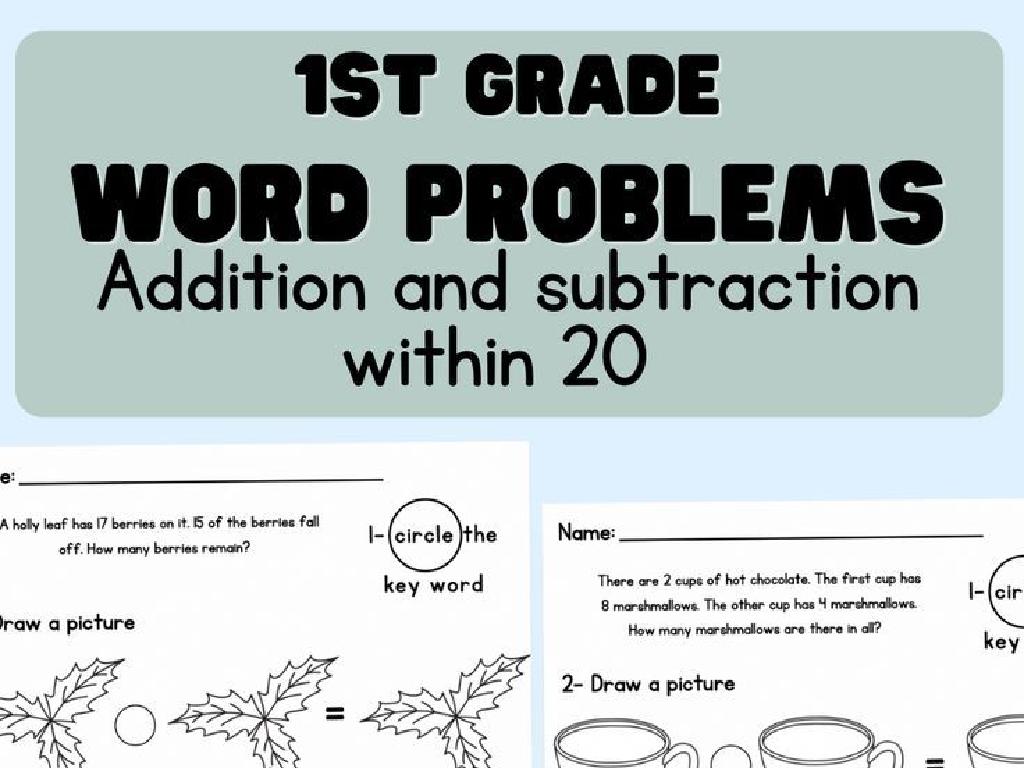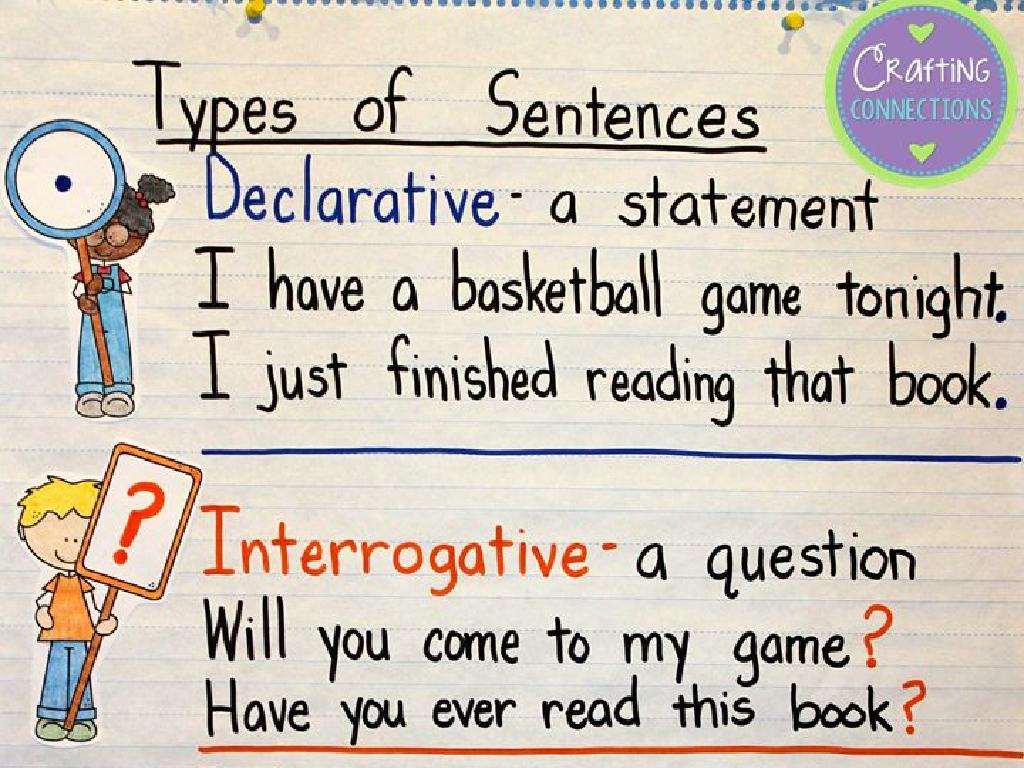Complete An Increasing Number Pattern
Subject: Math
Grade: Fourth grade
Topic: Patterns And Sequences
Please LOG IN to download the presentation. Access is available to registered users only.
View More Content
Increasing Number Patterns
– Explore patterns in daily life
– Patterns exist everywhere: in nature, art, music.
– Recognize increasing sequences
– Sequences where each number is larger than the previous.
– Understand patterns’ significance
– Patterns help predict and understand real-world situations.
– Apply patterns to solve problems
– Use patterns to anticipate the next number in a series.
|
This slide introduces the concept of increasing number patterns to fourth-grade students. Begin by discussing the prevalence of patterns in the world around us, from the petals on a flower to the rhythm of a song. Emphasize the importance of recognizing patterns, particularly increasing sequences, where each term is greater than the one before it. Explain how understanding patterns is crucial for making predictions and grasping complex concepts in mathematics and beyond. Conclude by illustrating how this knowledge can be applied to solve problems, such as figuring out the next number in a sequence. Encourage students to think of examples and share their thoughts on why patterns matter.
Understanding Number Patterns
– Define a number pattern
– A sequence with a specific rule for progression
– Patterns in the world around us
– Nature’s spirals, rhythms in music, motifs in art
– Types of patterns
– Numeric, geometric, color, and object patterns
– Recognizing patterns
|
Introduce the concept of patterns to the students by defining what a pattern is and explaining that it is a sequence that follows a particular rule. Provide relatable examples from nature, such as the arrangement of leaves on a stem or the symmetry in a snowflake, as well as from art and music, to illustrate the concept of patterns in everyday life. Discuss different types of patterns, including those with numbers, shapes, and colors, to give students a broad understanding of the topic. Emphasize the importance of recognizing patterns as a fundamental math skill that can help in predicting and understanding more complex concepts. Encourage students to observe and identify patterns in their environment.
Exploring Number Patterns
– Understanding increasing patterns
– Numbers that get larger in a sequence, like 2, 4, 6, 8…
– Recognizing decreasing patterns
– Numbers that get smaller, such as 10, 8, 6, 4…
– Identifying repeating patterns
– Sequences that repeat, like 5, 10, 5, 10…
– Practice with examples
– Let’s try finding patterns in sequences together!
|
This slide introduces students to the concept of number patterns, focusing on increasing, decreasing, and repeating sequences. Start by explaining that an increasing number pattern is a sequence where each number is larger than the previous one. Provide examples and ask students to create their own. For decreasing number patterns, illustrate with numbers that become smaller. Repeating patterns should be shown as sequences that cycle through a set of numbers. Encourage students to look for and extend patterns, and prepare to engage them with hands-on examples where they can apply what they’ve learned.
Understanding Increasing Number Patterns
– What is an increasing pattern?
– A sequence where numbers grow larger
– Each number is greater than the last
– If we have 2, 4, then next is >4
– Recognizing patterns in sequences
– Look for the rule that numbers follow
– Let’s find examples together
– Think of patterns you see at home or school
|
This slide introduces the concept of increasing number patterns to fourth-grade students. Begin by explaining that an increasing pattern is a sequence of numbers where each number is larger than the one before. Emphasize that there is a specific rule that numbers follow in these patterns. Encourage students to think of examples from their daily lives, such as the number of days in each month (28, 30, 31) or counting by twos (2, 4, 6, 8). Use this opportunity to engage the class in identifying patterns and understanding the concept of growth in a sequence. This foundational understanding will help them with more complex math concepts in the future.
Identifying the Rule in Number Patterns
– Patterns follow specific rules
– Rules determine pattern creation
– Practice finding the rule
– Look at examples and identify how the pattern grows
– Apply the rule to extend patterns
– Use the rule to complete or create new patterns
|
This slide introduces the concept of rules in number patterns. Emphasize to students that patterns are not random; they follow a specific rule that determines how the pattern is created and extended. Encourage students to observe patterns and identify the rule by looking at how the numbers change from one to the next. Provide several examples of increasing number patterns and guide students to articulate the rule for each. Once they understand the rule, have them apply it to extend the pattern or create their own patterns. Activities can include finding the next numbers in a given pattern or creating a pattern based on a rule you provide. This will help solidify their understanding of how rules govern the formation of patterns.
Creating Our Own Number Patterns
– Create a visual pattern using objects
– Use blocks or beads to make a sequence
– Turn the object pattern into numbers
– Write down the number of objects in order
– Share your number pattern with classmates
– Explain how your pattern grows to the class
– Discuss patterns observed
– Talk about the rules that make up the pattern
|
This slide is designed to engage students in understanding increasing number patterns through hands-on activity. Students will use tangible objects like blocks or beads to create a visual pattern, which they will then translate into a numerical sequence. This helps them grasp the concept of patterns in a concrete way. After creating their patterns, students will share with the class, explaining how their pattern increases and what rule it follows. Encourage students to observe the patterns made by their peers and discuss the similarities and differences. This activity fosters a collaborative learning environment and enhances critical thinking skills.
Practice Time: Increasing Number Patterns
– Observe the given patterns
– Apply the rule to find the next numbers
– If the pattern is 2, 4, 6, what comes next?
– Complete the blanks in your worksheet
– Use the patterns on the worksheet to practice
– Check your answers with a partner
– Discuss your answers and reasoning with a classmate
|
This slide is for a class activity focused on recognizing and completing increasing number patterns. Students should first observe the patterns provided, then use the identified rule (e.g., add 2) to find the subsequent numbers in the sequence. They will fill in the blanks on their worksheets with the next numbers in each pattern. After completing the activity, students should pair up to compare answers and discuss their methods. This peer interaction encourages collaborative learning and helps students articulate their thought process. As a teacher, circulate the room to offer guidance and ensure that students understand the concept of increasing patterns. Possible variations for different students could include using different starting numbers, varying the increments, or providing patterns with missing middle terms to challenge higher-level thinkers.
Real-Life Number Patterns
– Patterns exist beyond math class
– Examples: Daylight hours, savings growth
– Days gradually lengthen after winter; consistent saving increases money over time
– Recognizing patterns in daily life
– Spotting patterns helps us understand and organize the world
– Patterns help predict future events
– Knowing patterns lets us anticipate changes, like weather or finances
|
This slide aims to show students that patterns are a fundamental part of our daily lives, not just a mathematical concept. By recognizing patterns, such as the increasing daylight hours as seasons change or how regular saving can lead to a growing bank balance, students can relate to the importance of patterns in a practical context. Understanding patterns allows us to make predictions and informed decisions about the future, such as needing more sunscreen in the summer or how saving a little each week can help us buy something special later on. Encourage students to think of other patterns they encounter every day and how these patterns help them in their lives.
Class Activity: Pattern Scavenger Hunt
– Find increasing patterns around you
– Team up and list your findings
– Work with a partner to explore and write down different patterns
– Discuss the patterns you’ve found
– How did the numbers increase? What’s the rule?
– Present your patterns to the class
|
This interactive activity encourages students to observe their surroundings and identify patterns, fostering critical thinking and collaboration. Instruct students to look for sequences where each number is larger than the one before. They can work in pairs to encourage teamwork and discussion. Provide guidance on how to determine the rule of the pattern (e.g., add 2, multiply by 3). After the activity, facilitate a class discussion where each pair presents their findings, explaining the increasing sequence and the rule they discovered. Possible variations for different pairs could include finding patterns in nature, daily routines, or school timetables.
Conclusion: Increasing Number Patterns
– Key points on number patterns
– We learned to identify and extend patterns where each number is bigger than the last.
– Significance of patterns in math
– Patterns help us predict and understand mathematical concepts.
– Patterns in everyday life
– Recognizing patterns aids problem-solving and decision-making in daily activities.
– Homework: Craft a number pattern
– Create a sequence at home where each term increases and explain your rule.
|
In this lesson, students have learned how to identify and complete increasing number patterns, which are sequences where each term is larger than the previous one. Understanding patterns is crucial as it forms the foundation for algebra and helps in predicting future events. Patterns are not just a part of math but are also omnipresent in our daily lives, such as in music, art, and nature, aiding in problem-solving and decision-making. For homework, students are encouraged to create their own increasing number patterns, which will reinforce their understanding and allow them to apply what they’ve learned in a creative way. This task will also prepare them for the next class, where they will share and discuss their patterns.






